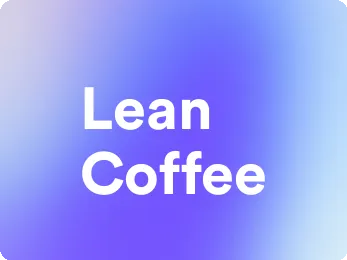Lean Coffee: A Productivity Tool for Efficient Meetings
This guide will walk you through the essential elements of using lean coffee - the productivity method to keep your team productive and engaged.
Try Lark for Free
Lean coffee is a meeting structure designed to facilitate productive and engaging discussions in a time-efficient manner. This article will provide an in-depth exploration of lean coffee, including its origins, the target audience, its advantages and disadvantages, how to initiate lean coffee sessions, actionable tips, do’s and dont’s, a step-by-step guide, and frequently asked questions.
What is Lean Coffee in the Context of Productivity?
Lean coffee is a structured, agenda-less meeting format that encourages engaged and in-depth conversations. Unlike traditional meetings, lean coffee sessions are driven by the participants, who collaboratively set the agenda and prioritize topics for discussion. This approach fosters a sense of ownership and accountability among the attendees, resulting in highly productive and focused conversations.
Lean coffee promotes open dialogue, allowing participants to address relevant issues, seek advice, and share experiences in a casual and constructive environment. The flexibility and adaptability of lean coffee make it a valuable tool for teams and organizations looking to streamline their meeting processes and enhance productivity.
What is the Origin of Lean Coffee?
The concept of lean coffee originated from the lean startup and agile development communities in Seattle. It was initially developed as a way to support communities of practice and provide them with a simple tool to collaboratively and democratically create an agenda, uncovering the topics that are most important for the group at that moment. Over time, the lean coffee format gained popularity as an effective approach to conducting focused and result-oriented discussions, transcending its origins to diverse professional domains.
Use Lark to unleash your team productivity.
Who is Lean Coffee For?
Lean coffee is well-suited for professionals, teams, and organizations that value participatory decision-making, open communication, and time efficiency. It caters to a wide range of industries and disciplines, including software development, project management, marketing, education, and more. Whether employed by small teams or large-scale enterprises, lean coffee can empower participants to generate actionable insights, identify obstacles, and collectively drive progress on key initiatives.
What are the Pros and Cons of Lean Coffee?
Pros
- Enhanced Engagement: Lean coffee encourages active participation and engagement among attendees, leading to meaningful interaction and knowledge sharing.
- Time Efficiency: The agile structure of lean coffee allows for focused discussions, ensuring that valuable insights are shared within a limited timeframe.
- Transparency and Collaboration: By enabling agenda setting and topic prioritization by the participants, lean coffee promotes transparency and collaborative decision-making.
Cons
- Lack of Structured Agenda: The absence of a pre-determined agenda may pose challenges for individuals who prefer structured meeting formats.
- Potential Topic Overload: Without clear moderation, lean coffee sessions may become overwhelming if numerous topics are introduced simultaneously.
Learn more about Lark x Productivity
How to Get Started with Lean Coffee
1. Establish the Meeting Environment
Select a conducive venue that facilitates open communication and collaboration. Ideally, provide ample space for participants to engage in discussions comfortably.
2. Invite Relevant Participants
Identify and invite individuals who can contribute diverse perspectives and insights to the topics at hand. Ensure the inclusivity of the participants to promote comprehensive discussions.
3. Introduce Lean Coffee Format
Outline the basic principles and guidelines of lean coffee, emphasizing the participatory nature of setting the agenda and the time constraints for each topic.
4. Set the Agenda
Distribute sticky notes or use digital platforms to allow participants to propose discussion topics. Encourage them to prioritize the agenda collectively.
5. Facilitate the Discussion
Allocate time slots for each topic and facilitate the conversation, ensuring active participation and adherence to the time constraints.
6. Evaluate and Iterate
Conclude the lean coffee session with a brief retrospective to gather feedback and insights. Use this feedback to refine future sessions for continuous improvement.
Use Lark to unleash your team productivity.
Actionable Tips for Lean Coffee
- Active Listening: Encourage active listening and open-mindedness among participants to ensure that diverse viewpoints are acknowledged and valued.
- Time Management: Adhere to the time limits set for each agenda item, fostering a sense of urgency and driving focused discussions.
- Reflection and Iteration: Embrace the retrospective element of lean coffee, leveraging insights from each session to refine the format for subsequent meetings.
Do's and Dont's
| Do's | Dont's |
|---|---|
| Encourage active participation | Avoid dominating discussions |
| Respect diverse viewpoints | Disregard time constraints |
| Set clear and concise topics | Overload the agenda with too many items |
| Foster a collaborative environment | Neglect soliciting feedback |
Conclusion
Lean coffee has emerged as a transformative tool for organizations and teams seeking to maximize the value of their meetings. By promoting inclusivity, engagement, and focused discussions, lean coffee empowers participants to drive meaningful outcomes and foster a culture of continuous improvement.
Lean coffee not only revolutionizes the way meetings are conducted but also enhances collaborative decision-making and knowledge sharing, making it a valuable asset in the pursuit of productivity and efficiency.
